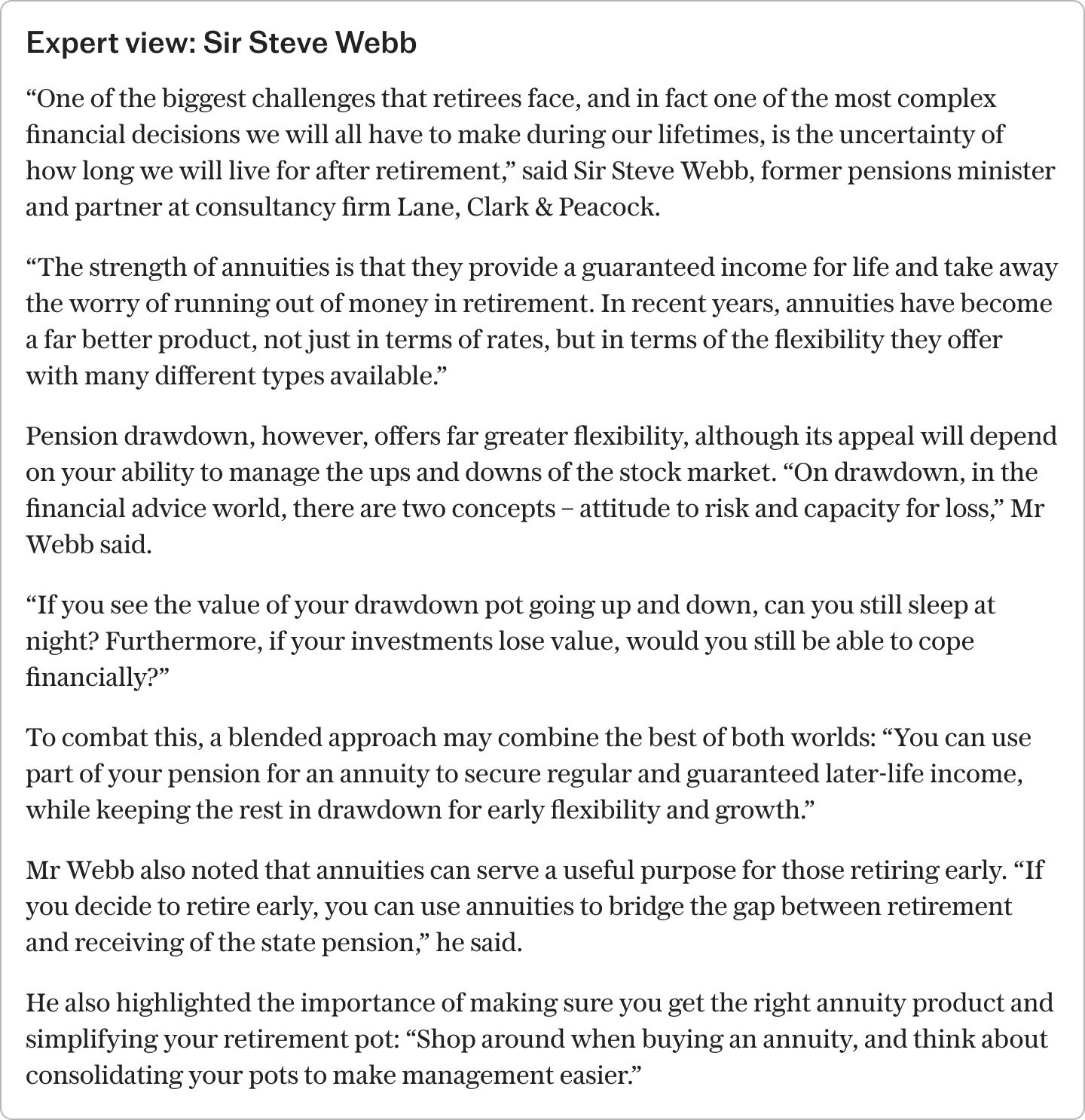Pension drawdown vs annuities

Deciding what to do with your pension savings when you retire can often be a tough decision.
Is your capital growth rate capable of outpacing inflation, or would a combination of both be ideal?
This guide by Telegraph Money will walk you through the advantages and disadvantages of both possibilities to assist you in your decision-making process.
Here's what we'll be covering in this guide:
- What is an annuity?
- What is pension drawdown?
-
I'd be delighted to help with questions relating to comparing annuities and pension drawdown.
Understanding the differences between annuities and pension drawdown is a crucial aspect of retirement planning. When deciding between these two options, it's essential to consider various factors, including your financial goals, risk tolerance, and individual circumstances.
**What are annuities and pension drawdown?**
An annuity is a type of investment that provides a guaranteed income stream for a set period or for life. You'll typically pay a lump sum or series of payments, usually from a pension pot. In exchange, the annuity issuer guarantees a regular income, often with a fixed or increasing value to keep pace with inflation.
Pension drawdown, on the other hand, is a way of taking money from your pension pot while it remains invested. This allows you to extract cash as and when you need it, without creating a regular income stream.
**Differences between annuities and pension drawdown**
Here are some key differences to consider when choosing between annuities and pension drawdown:
1. **Guaranteed income:** Annuities provide a guaranteed income for the rest of your life or a set period, while pension drawdown requires you to manage your investments to generate income.
2. **Flexibility:** Pension drawdown allows you to access your money as and when you need it, while annuities usually require you to commit to a fixed income stream.
3. **Tax implications:** The tax implications of annuities and pension drawdown can be complex. It's recommended to consult with a financial advisor to understand how it will affect your individual circumstances.
4. **Investment risks:** Pension drawdown carries investment risk as your income is tied to the performance of your pension investments. Annuities, on the other hand, shift investment risk to the issuer, but you'll usually achieve a lower return.
5. **Fees and charges:** Annuities often come with setup fees and charges, but these are usually offset by the guaranteed income stream. Pension drawdown may involve fees and charges for investment management services. -
Here is the paraphrased text:
You should consider each of the options carefully to determine which one is most suitable.
- **Multi-domain results**: This option may be a good choice when you're unsure which domain is most relevant to your search query. This option can provide a comprehensive list of results from across various domains.
- **Domain-specific results**: This option, on the other hand, might be more appropriate when you're searching within a specific area of interest. This choice can help you find the most relevant and precise information from a particular domain.

What is an annuity?
An annuity is a financial plan that offers a secure, regular income, which can continue for either a fixed period or throughout your lifetime, depending on your chosen option.
.
Annuities can provide a secure source of income for life, giving people peace of mind during their retirement years," notes Steven Cameron, who works for the UK pension provider Aegon. "You have the freedom to choose whether you want your payments to increase annually to keep pace with inflation, receive a fixed yearly amount, or, if desired, ensure the annuity will continue to pay out to a surviving partner.
Here are some of the main features that annuities typically have:
- Long-term annuity contracts offer a guaranteed income stream, either on a monthly basis for the rest of your life or for a set number of years. However, if you opt for the lifetime annuity and pass away in the short-term, it could prove to be a costly decision. On the other hand, if you enjoy a long life, this type of annuity can provide excellent value for your money.
- An annuity is typically bought using a single payment at the very beginning of the arrangement.
- A significant factor to consider when purchasing an annuity is that once a decision has been made, it is irreversible, and any subsequent regrets cannot be addressed.
- With annuities, you are usually unable to alter the investment of the funds or the monthly amount you receive, unless other arrangements have been made.
- The worth of an annuity takes into account factors including your age, health, the value of your pension and interest rates at the time of purchase.
Some unfortunate people may find annuities' rigid nature unappealing," Mr Cameron pointed out. "Once these contracts are bought, customers are locked in to the specific terms, underlining the need to thoroughly consider how much secure income is required before coming to a decision.
What is pension drawdown?
With pension drawdown, you can keep your pension pot invested while in retirement and take out amounts as and when you need them.
When you enter retirement drawdown phase, it's essential to keep managing your investments. In contrast to annuities, drawdown provides greater flexibility and the chance for your investments to grow. A notable advantage is that any remaining funds can be left to your loved ones when you pass away, which isn't possible with most annuity options, unless you opt for a joint life annuity.
However, while a drawdown allows for flexibility in how much you withdraw and how your funds are invested, it brings the risk of rapidly depleting your pot if withdrawals are too high or investments do not perform as expected.
One drawback of taking a drawdown is that, if you withdraw too much too quickly or your investments don't perform well, you may find yourself running out of money," said Mr Cameron. "This highlights the importance of closely monitoring your pension pot or consulting with a financial advisor to create a long-term withdrawal plan.
It can assist you in determining whether you require a modification to your present approach.
Certain essential aspects of pension drawdown comprise:
- You can adjust the amount and frequency of your withdrawals based on your desired withdrawal amount.
- Despite your pensions investments being invested as you've been putting money away, there's a chance they may still increase in value after you start collecting your pension.
- As with any investment, there is an element of risk attached to pension drawdown. Your investments may fall short of expectations and it cannot be guaranteed they will increase in value as you had hoped.
- When taking pension drawdown, you have the flexibility to alter your investments as you go along. Additionally, you can switch your pot to an annuity at any point.
- .
"In considering annuities and pension drawdown, there are several key factors to think about.
Pension drawdown allows you to use a portion of your pension pot to purchase a regular income, whereas an annuity typically provides a fixed income for a set number of years. This means that with drawdown, the income can vary depending on how well investments perform.
Some key points to bear in mind when deciding between these options are:
* **Flexibility**: With pension drawdown, you have more control over your money and can typically make more flexible decisions regarding your income and investments.
* **Guarantees**: An annuity provides a guaranteed income for a set period, whereas with drawdown, the income may change over time due to investment fluctuations.
* **Risk**: With pension drawdown, you're exposed to market risk, whereas an annuity typically offers a fixed income, but you should also consider any associated fees.
* **Tax efficiency**: You'll pay tax on the income you take from a drawdown plan, whereas an annuity income is considered taxable as income.
"It's worth noting that your choices can have significant implications for your long-term wealth. Careful consideration of these factors, as well as your personal circumstances, can help you make an informed decision.
Annuities and pension drawdown are two very different choices, and this is evident when comparing them in key areas, as illustrated in the table below:
"We looked into the topic of investing in silver coins as one of the safest forms of investment compared to gold and other precious metals. The options considered are:
- Bullion coins, which are coins manufactured by government or recognised mints. They are considered valuable because of their content rather than collectibility or rarity.
- Numismatic or collector coins, which may have value due to their rarity or collectibility.
- Investment worth of the coin holder, where the value comes from the packaging and certification.
Holding, storing and delivery costs will also be considered.
When deciding which option to buy, investors should consider the following points:
-
i. Safety: Government-backed bullion coins are generally more secure compared to numismatic coins, which have a higher risk of being stolen or lost.
ii. Team prices: Bullion coins have a higher price per ounce compared to numismatic coins.
iii. Capital gains when bought in low price conditions- Any gains in the investment depend on obtaining benefits at the lowest costs in both charge and denominations.
Annuities are commonly regarded as a more cautious choice, and are often preferred by those who are hesitant to take risks, prioritising the certainty of a regular monthly income.
Drawdown pensions suit individuals who prefer flexible financial arrangements, allowing them to stay invested in the stock market after leaving work.
Figuring out the best way to prepare for retirement is a challenging business, relying on several key factors which can be very different for each individual. This makes it a thoroughly difficult decision, and seeking guidance from a financial expert could be incredibly useful in helping you come to the right choice, tailored to your specific needs.
The blended approach: A hybrid strategy that links both annuities and drawdown options.
There's the choice to combine both annuities and pension drawdown to create a blended retirement plan.
People don't have to choose between one option or the other," said Mr Cameron, "what many aim to do is make sure they have a reliable stream of income from sources like the state pension or final salary pensions, covering their essential spending needs.
“Some individuals opt for annuities, obtaining additional guaranteed income, with the rest of the funds allocated to a flexible drawdown option."
If you elect to combine your retirement plans, you also have the option to switch your pension savings into annuities at a later stage.
It's crucial to be aware that buying an annuity is a final decision on your part. On the other hand, with drawdown, you have the possibility to convert your funds into a steady income stream by buying a secure annuity at a later point, such as at age 75 or 80.
Discover The Telegraph's engaging selection of Puzzles and brighten up your day. Challenge your mind and uplift your mood with PlusWord, the Mini Crossword, the demanding Killer Sudoku and the iconic Cryptic Crossword.
Post a Comment for "Pension drawdown vs annuities"